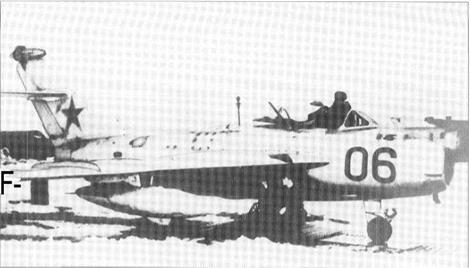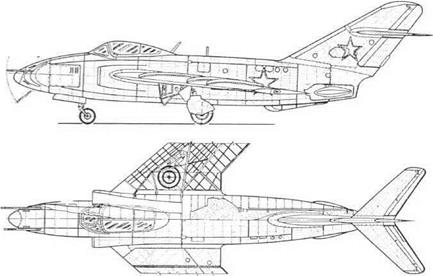MiG-17 Experimental Versions
Design Bureau: OKB-155 ofAI Mikoyan.
Throughout 1949 the MiG OKB was busy creating the SI, the prototype of a MiG-15 derivative incorporating numerous improvements. Most of these were aerodynamic, including a completely redesigned wing, a horizontal tail of increased sweep on an extended rear fuselage, and improved flight controls. The first flight article, SI-2, was flown on 13th January 1950, and on 1st September 1951 MAP Order No 851 required the SI to be put into production as the MiG-17. Because of the sheer momentum of MiG-15 production the improved aircraft did not replace it in the factories until October 1952. The following specification refers to the MJG-17F, by far the most important version, which was powered by the afterburning VK-1F, with a maximum rating of 3,380kg (7,451 Ib).
|
Dimensions Span Length Wing area |
9.628 m 11.26m 22.64 m2 |
31 ft 7 in 36 ft 1 Min 243.7 ft2 |
|
Weights |
||
|
Empty |
3,940kg |
8,686 Ib |
|
Fuel/oil |
1,170kg |
2,579 Ib |
|
Loaded (clean) |
5,340kg |
1 1,772 Ib |
|
(maximum) |
6,069 kg |
13,380 Ib |
|
Performance Maximum speed |
||
|
at sea level |
l,100km/h |
684 mph |
|
at 3,000m (9,842 ft) |
l,145km/h |
71 1.5 mph |
|
Mach limit |
||
|
(clean over 7,000m) |
1.15 |
22,966ft |
|
Time to climb (afterburner) |
||
|
to 5,000 m |
l. Smin |
16,404ft |
|
to 10,000m |
3.7 min |
32,808ft |
|
Service ceiling |
||
|
(still climbing 3.6 m/s) |
16,600m |
54,462 ft |
|
Range (clean) |
1,160km |
721 miles |
|
(maximum) |
1,940km |
1,205 miles |
|
Take-off speed/ |
235km/h |
146 mph |
|
run |
590m |
1,936ft |
|
Landing speed/ |
180km/h |
112 mph |
|
run |
850m |
2,789 ft |
SN
In late 1953 the MiG Factory 155 produced an experimental fighter representing the next stage beyond the SU. This time the entire forward fuselage was redesigned to house the pivoted guns, the engine being fed by lateral inlets and ducts passing both above and below the wing torsion box (which was given front and rear fairings). Ahead of Frame 13 the entire nose was occupied by the SV-25 armament installation devised by the TKB (Tula design bureau) of Afanas’yev and Makarov. This was based on a large frame mounted on needle-roller bearings on each side and pivoted on a transverse axis over the range +27° 267-9° 28′ (not 9° 48′ as previously published). On this frame were mounted three TKB-495 lightweight 23mm guns, fed by box magazines mounted on the fixed structure. The whole installation weighed 469kg (l,0341b), requiring a balancing increase in the size of Tank 3 in the rear fuselage. As this


![]()

aircraft was so non-standard anyway the OKB took the opportunity to try a few other changes. Of course a special gunsight was needed, and it may have been to improve the optics that a new windscreen was designed, wider and longer than before and giving a better field of view ahead. The SN was factory – tested by Georgiy K Mosolov from mid-1953. It proved a failure, with seriously reduced flight performance and useless armament. Because the guns were so far ahead of the centre of gravity and centre of pressure of the aircraft, firing them at large angles from the horizontal caused powerfulpitchingmoments which threw the aim off-target. Mikoyan decided the problem was not readily soluble. Numerous otherwise unmodified MiG-17s were also used as armament test-beds.
SI-10
This MiG-17 was one of the original type with the non-afterburning VK-1A engine, with callsign 214. Having studied the wing and tail of the F-86E Sabre, this aircraft was fitted with important aerodynamic and control changes. The wing was fitted with large automatic slats over the outer 76 per cent of each leading edge, large area-increasing (Fowler-type) flaps, and spoilers (called interceptors) under the outer wings which opened whenever the adjacent aileron was deflected more than 6°. In addition, a fully powered irreversible tailplane was fitted, with limits of +37-5°, retaining the elevators driven by a linkage to add camber. Grigorii A Sedov flew No 214 on 27th November 1954, followed by many other OKB and NIl-WS pilots. Opinions were favourable, especially regarding the horizontal tail, but it was not worth disrupting MiG-17 production to incorporate the changes.










